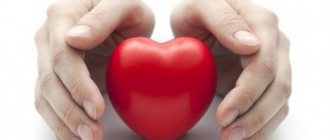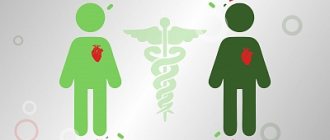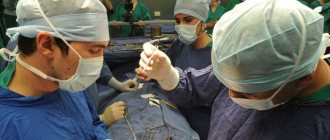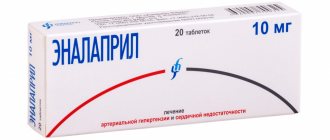1.What is heart transplantation?
Heart transplant
- a procedure in which a surgeon removes a patient's heart and replaces it with a donor one. During surgery, a mechanical pump circulates blood throughout the body while the surgeon transplants a healthy heart from a recently deceased donor.
The surgeon attaches the donor heart to the main blood vessels and attaches wires to it that will temporarily control the heartbeat. The whole procedure takes several hours.
To prevent rejection of the donor heart, the surgeon gives the patient strong medications (immunosuppressants) immediately after the operation. The patient will need to take such drugs for some time.
A must read! Help with treatment and hospitalization!
What influences the success of the operation?
The success of the operation will depend on a number of factors:
- The time it will take to find a suitable donor. Patients who are indicated for transplantation already have severe pathology that threatens their lives. Long waits can be fatal. In this case, the sooner the operation is performed, the greater the likelihood of a positive outcome.
- The time it will take to transport the donor heart. Transportation and implantation must be carried out within 3-6 hours after its removal from the body. After this period, the organ loses its viability, as irreversible structural changes occur in it. The heart is transported in a medical insulated box filled with a cardioplegic solution.
- Qualification and experience of the operating cardiac surgeon.
2.Rehabilitation after surgery
What to expect after heart transplant surgery?
Recovery process after heart transplant surgery
similar to other heart surgeries.
You will most likely spend a couple of weeks in the hospital. In some cases, you will need more time depending on how your health is assessed and whether there are complications after surgery. At the hospital, you will begin a cardiac rehabilitation program.
. Your doctors will check to see if the donor heart is taking root in your body.
Rehabilitation after heart transplant
A rehabilitation program will help you recover and become active again after your heart transplant.
The donor heart can respond to stress in different ways. Your heart rate will not rise as much as before. The heartbeat will also return to normal in a different way. This occurs because some of the nerve connections that control the heart were cut during surgery.
Visit our Cardiology page
Postoperative period
After the operation, the patient is under medical supervision for a long period of time. During this period, immunosuppressive therapy with the help of hormones and cytostatics is selected, thanks to which it is possible to avoid rejection processes, the condition of the postoperative wound is assessed, and complications are corrected if they arise.
In the first month after surgery, a myocardial biopsy is performed every 1.5-2 weeks. This is necessary to assess the condition of the donor heart. Over time, this procedure is performed less and less often.
3.Indications for heart transplant surgery
Heart transplant surgery is performed when the heart stops working and the patient is on the verge of life and death. Heart transplantation is also performed if the patient has serious heart disease and only surgery provides the best prognosis for recovery. A patient may be recommended for a heart transplant if he:
- End-stage heart failure, coronary artery disease, cardiomyopathy, or congenital heart disease.
- Low chances of living longer than a year without a heart transplant.
- Absence of any other serious medical reasons that reduce life expectancy.
- If the attending physician believes that a heart transplant will increase the length and quality of life.
Some medical centers require heart transplant candidates to provide evidence that they have stopped smoking and/or have been sober for an extended period of time (4-6 months) before being placed on the transplant list.
About our clinic Chistye Prudy metro station Medintercom page!
Is it possible to transplant an adult's heart into a child?
An adult cannot become a donor for a child because the transplanted organs must match each other in size. Unlike liver and kidney transplants, where adult donors are used for children, a heart can only be transplanted from child to child of approximately the same age.
In world medical practice, there are examples of successful heart transplants in children under 5 years of age. In our country, such operations are carried out after the child reaches 10 years of age.
Heart transplantation is much more difficult for a child than for an adult. In addition to the difficulties associated with finding a donor, it should be taken into account that a child’s fragile body is more difficult to tolerate long-term use of necessary medications. In children, late rejection of biomaterial occurs more often and complications progress faster, leading to death.
4.Risks of heart transplant
The main risks of heart transplant surgery include:
Rejection of a donor heart.
To check the patient's body, surgeons regularly perform biopsies of heart tissue, as well as echocardiography, electrocardiography, or blood tests.
If the patient's body rejects the heart, additional medications (immunosuppressants or steroids) are prescribed to suppress the immune system so that it will accept the donor heart. These medications may have side effects, the most serious of which are various infections and the development of cancer.
Atherosclerosis of the arteries, which could appear in the donor heart
. This is usually a complication and at the same time an important limiting factor that affects life expectancy.
Things to think about
After a heart transplant, you must follow strict life rules, which include taking daily medications and regular medical care. Medical care involves ongoing testing (biopsies) of tissue from the transplanted heart to prevent rejection.
Transplant candidates receive a heart based on the date of registration and the severity of the disease. Also, do not forget that the number of donor organs is limited.
Where do donors come from?
As a rule, people most often become donors after a serious accident. They are in intensive care, and their brain must be dead, that is, such people have no chance of survival, and the functioning of their body is supported artificially, with the help of medications and a ventilator.
In this case, relatives may decide to donate this person’s organs. To do this, they need to sign the appropriate documents.
And also the person himself can make a will during his lifetime, which will indicate that after death he donates his organs for medical needs.
Progress and technique of the operation
Under general anesthesia, the patient's sternum is dissected, the pericardial cavity is opened, and connected to artificial circulation.
Experience has shown that the donor heart requires “adjustments”:
- the opening between the atria and ventricles is examined, and if it is not fully opened, suturing is performed;
- they strengthen the tricuspid valves with a ring to reduce the risk of exacerbation of pulmonary hypertension, overload of the right side of the heart and prevent the occurrence of failure (occurs in half of patients 5 years after transplantation).
The ventricles of the recipient's heart are removed, the atria and large vessels remain in place.
The donor's implanted heart is sutured to the patient's own remains
There are 2 methods of transplant placement:
- Heterotopic - it is called a “double heart”, indeed, it is not removed from the patient, but the graft is placed nearby, a position is selected that allows the chambers to be connected to the vessels. In case of rejection, the donor's heart may be removed. The negative consequences of the method are compression of the lungs and new heart, creation of favorable conditions for the formation of wall blood clots.
- Orthotopic - the donor heart completely replaces the removed diseased organ.
The transplanted organ can start working on its own when connected to the bloodstream. In some cases, electric shock is used to start.
A temporary pacemaker is installed to maintain and control the rhythm. Drainage tubes are placed in the chest cavity to drain accumulated blood and fluid.
The sternum is secured with special staples (it will heal after 1.5 months), and sutures are placed on the skin.
Different clinics use modified surgical techniques. Their goal is to reduce trauma to organs and blood vessels, prevent increased pressure in the lungs and thrombosis.
Information about first transplants
The first attempts were made in the middle of the last century, but most of them were unsuccessful: the recipients died. This was due to lack of equipment, immunosuppressive treatment, inexperience and understanding of the problems.
The first successful transplant was performed by Christian Barnard in 1967. This marked the beginning of a new stage in transplantation, and the introduction of cyclosporine in 1983 further accelerated this process.
The drug increased the chances of patients by improving the implantation of a donor heart.
Despite the advances in medicine, modern transplantology experiences a large shortage of donor organs. This is due to legal regulations and lack of public awareness of the importance of transplantation.
Possible complications
After the operation, the recipient is left with a scar from the incision on the chest, which begins at the sternoclavicular joint and extends down to the navel. In order not to attract undue attention from others and to live as before, patients are forced to hide it under high-necked clothing, or use special camouflage cosmetics.
The most dangerous and difficult period, requiring maximum adaptation of the body to the new organ, is the first ten days after the transplant.
At the initial stage of engraftment, the following complications may occur:
- graft rejection;
- thrombosis of large arteries and vessels;
- development of the infectious process;
- internal bleeding;
- congestion in the lungs, pneumonia;
- kidney and liver pathologies;
- effusion pericarditis (inflammation of the pericardium, which is accompanied by an increase in effusion fluid in its cavity);
- arrhythmias.
In addition, there are late complications that can appear both during the first year and several years later:
- development of cancer (melanoma, lymphoma, myeloma, etc.);
- myocardial infarction;
- ischemia;
- valvular insufficiency;
- atherosclerosis;
- vascular diseases - vasculopathy.
Lifespan
After heart transplantation, the survival rate after one year is 85%. Subsequently, some patients develop rejection, changes caused by infectious diseases, and this percentage drops to 73%.
A life expectancy of more than 10 years is found in less than half of all heart transplant patients.
In general, the new heart functions for 5 to 7 years, but it is more susceptible to degeneration than the healthy original organ.
The person may gradually feel worse, but there are cases where the person is still in good health even after such a long period of time.
Life after transplant
A heart transplant is a surgical procedure to remove a damaged or diseased heart and replace it with a healthy donor heart. Most heart transplants are performed on patients with end-stage heart failure. Finding a donor heart is the most time-consuming process. The donor heart should be matched to your tissue type to reduce the chance of heart rejection. Heart transplantation is used as a life-saving measure. About 88% of patients survive the first year after transplant and 75% survive 5 years. The 10-year survival rate is 56%.
Why is a heart transplant necessary?
A heart transplant is required for several reasons. The most common cause is the lack of full ventricular function of the myocardium and the presence of severe heart failure. Ventricular failure occurs with congenital heart defects, but is more common with congenital defects of one ventricle or structural abnormalities of the valve. Although transplantation is a life-saving measure, it has many risks.
What are the risks after a heart transplant?
Impaired functioning of the donor heart
The most common cause of death in the first month after transplantation is primary graft dysfunction, which is accompanied by dysfunction of the donor heart. Factors such as trauma to the donor's heart or narrow blood vessels in the patient's lungs often lead to primary dysfunction.
Donor heart rejection
Rejection is the cause of patient death within the first year after transplantation. The recipient's immune system treats the new heart as a foreign object and attacks it. Rejection occurs within 6 months after transplantation.
Cardiac allograft vasculopathy
This condition is associated with impaired elasticity of the wall of the coronary arteries. In the new heart they become dense and hard. This interferes with blood circulation and causes serious damage. Cardiac allograft vasculopathy is one of the causes of heart failure and death in the first years after transplantation. Often causes heart attacks, dangerous arrhythmias and sudden cardiac arrest.
Complications from medications
Taking medications that block the immune system from attacking immune cells on the new heart causes serious side effects. They can cause kidney damage. Kidney damage occurs in 25% of patients in the first year after transplantation.
Infection
Infection is the leading cause of hospitalization in heart transplant patients. It is also one of the causes of death during the first year after transplantation. Most often, patients are susceptible to infectious processes due to the use of immunosuppressants.
Cancer
Suppression of the immune system increases the risk of developing cancer and malignant neoplasms. Malignant processes are one of the causes of death after transplantation.
Living with immunosuppression after organ transplant
Your body's defenses are always on the lookout for pathogenic microorganisms and other foreign organisms. Unfortunately, this means that your body is not a very hospitable host. It tries to heal the transplanted organ that saved your life, just like any normal pathogenic agent. It attacks. Organ rejection is a misguided attempt by your body to protect you. This is why immunosuppression is used. Immunosuppressive drugs can block the action of these natural defenses. Usually they allow your body to live in complete harmony with the new organ. But the problem is that by blocking this protection, you will become more vulnerable to infections. This sacrifice has to be made in order to carry out the transplant. “Living with a transplant is always a balancing act between rejection and infection.” You must take enough medications to prevent organ rejection. But you can't take so much medicine that it could increase your risk of infection too much." The good news is that doctors are now making significant progress in maintaining this balance. No, you don't have to live in a sterile bubble to stay healthy. And after the first weeks or months after the transplant, living with the restrictions of your life will not be so difficult. “In general, if you lead a reasonable and fairly healthy lifestyle, you will be fine. What precautions will I need to take after the transplant? Immediately after an organ transplant, you will be extremely vulnerable. You will be in the induction phase of immunosuppression. You will be taking fairly high doses of immunosuppressive drugs, so you will need to monitor yourself carefully.
You must:
1.Wash your hands often. Hand washing is an excellent method to reduce exposure to microorganisms. It is especially important to do this before meals.
2. Avoid communicating with sick people. It is best to limit your contact with people who are sick with ARVI or any other infection, such as measles or chickenpox. Avoid people who have recently been vaccinated. Some vaccines, such as the new nasal flu vaccine or the measles vaccine, contain a live virus. This may pose a risk to people with weak immune systems. 4. Avoid crowded places. For example, avoid large shopping complexes and cinemas.
5.Do not take part in caring for pets. Pets can carry pathogens, so limit your interactions with them. You shouldn't kick them out of the house. Instead, look at this as an opportunity to delegate the responsibility of cleaning up your pet's mess and maintaining their hygiene to your spouse or children.
6.Do not garden. Some dangerous bacteria live in the soil. So let your garden go wild for a few months. Or ask the children to do the weeding for you.
7.Brush your teeth daily with a toothbrush and floss. This will help protect your mouth from infection. Therefore, brush your teeth daily. 8.Do not ignore cuts and scratches. Rinse them and apply a bandage. Contact your doctor immediately if you have any signs of infection.
9. Have very safe sex. Sexually transmitted diseases such as herpes can be a problem for anyone. But for a person with a transplanted organ, they can be really dangerous. Even condoms cannot protect you completely. Colds or viruses can even be transmitted through saliva. Ask your doctor what is safe for you. Naturally, specific recommendations depend on your health and your situation. The differences may even depend on where you live. If you live in a city, it will be more difficult to avoid crowded places. Living in rural areas also poses many dangers, such as exposure to livestock or potentially dangerous water. Check with your doctor for such recommendations. Precautions throughout life after organ transplantation. Over the next six months to a year after your organ transplant, the team of doctors who are monitoring your health will likely reduce the dosage of your medications in the “maintenance phase.” You will take the lowest dose possible. At this time, you can relax your precautions a little. You will not be susceptible to infection. But you will still have to follow safety precautions. Wash your hands regularly and limit contact with people who are sick or have recently been vaccinated. If you have ever had an episode of organ rejection, your doctor may need to change your medications or increase the dose of the immunosuppressive medications you take. This is called anti-rejection immunotherapy. Since your immune system will be depressed, you will again need to take some additional safety precautions. Your doctor may also change some medications from time to time. Some of them may perform worse over time. Also, new, more effective medications may appear on the pharmaceutical market that will replace the old ones you are taking. Taking your medications after organ transplantation. Life after an organ transplant usually means taking a lot of medications. Most people take six to 12 different medications every day. And maybe more. Taking so many medications may sound daunting. Some people may be overwhelmed by the amount of medication they will need to take. But you must remember that you were already sick and were on a complex medication regimen. Most people actually find that their medication regimen has become less complex after transplantation. Taking your medications is absolutely necessary to keep you healthy. Here are some tips.
1.When it comes time to take medications needed after transplantation, strictly follow your doctor's advice.
2.Use weekly or daily pill boxes so you can set and track your doses in advance. 3.Use alarms, timers and digital clocks to help you remember your doses.
4.Ask your family members to help you stick to your medication schedule.
5.Keep your medications away from children and pets. 6.Keep your medications in a cool and dry place. 7.Keep a list of all your medications in a visible place.
8.If you miss a dose, do not double the dose the next time you take it.
9.Keep track of how much medication you have left. Always call your pharmacy for a timely refill.
10.If as directed by your doctor, take your medications with food to prevent gastrointestinal side effects.
11. Plan your medication intake so that it can be correlated with your daily activities, such as brushing your teeth, eating lunch, or going to bed.
12.Never stop taking medications without your doctor's consent.
Dealing with drug side effects
Drugs you will take after your transplant The medications you take after your transplant that suppress your immune system are very powerful. Unfortunately, they can harm the entire body. This means that they affect the entire body, rather than suppressing only the immune response to the transplanted organ. So the bad news is that you may experience adverse reactions to your medications. The good news is that these effects can be managed. Specific side effects may vary. This depends on the combination of post-transplant medications you are taking. Here is a general list of side effects you may experience:
- Nausea and vomiting
- Diarrhea
- Headache
- High blood pressure.
- High cholesterol levels.
- Puffiness of the face.
- Anemia.
- Arthritis.
- Brittle bones.
- Increased appetite.
- Weight gain.
- Sleep problems.
- Mood swings.
- Swelling and tingling sensation in the arms and legs.
- Acne and other skin problems.
- Tremor.
- Hair loss and unwanted hair growth.
Yes, it's a long list. But don't worry too much. Not everyone experiences these side effects. One recipient's response to an organ may differ significantly from another.
Remember to report any adverse reactions to your doctor. He or she may be able to change your medications. Or your doctor may find other ways to treat these problems. There is no need to suffer unnecessarily. Taking other medications after transplantation. In some cases, you may need to take more medicine to manage side effects. For example, you can take:
1.Antibiotics and antifungal drugs. They are used to treat an infection caused by suppression of your immune system.
2. Antiulcer drugs. Used to treat adverse reactions from the gastrointestinal tract.
3. Diuretics. They help cope with kidney problems or high blood pressure.
Many people only need additional medications during the early stages of their treatment. As your doctor lowers your dose of your immunosuppressant medications, side effects may bother you less or go away altogether.
Because organ transplant recipients need to take so many medications, they must be very careful about drug interactions. Make sure your doctor knows about all the medications you take. Including about drugs sold without a prescription or herbal medicines. Even some foods, such as grapefruit juice, can interact with certain medications.
Life after transplant:
Safe physical activity. Getting back to an active life after transplant with exercise and other physical activities It is common for transplant recipients to worry about damage to their new organ. Physical activity can feel risky. Cycling or roller skating, which you are used to, may seem like rash actions. After all you have gone through to receive an organ for transplant, the last thing you want is for it to be damaged. “Such caution is a normal reaction, but you are not as vulnerable as you think. Physical activity is usually not dangerous for organ transplant recipients. Often this is the key to maintaining health. Exercise helps people who have had a transplant just as much as anyone else. They lower your blood pressure, help your heart and reduce your weight. Physical activity also helps you fall asleep and relax. And by exercising, you will simply feel better. How long will it take to return to normal exercise capacity? Of course, you won't be able to return to the tennis court right away. But the recovery period after transplantation usually does not take longer than after other types of surgical interventions. Recovery may be slightly slower due to the medications you may need to take to prevent organ rejection. After staying in the clinic for about a week—longer for heart or lung transplant patients—most people can go home. You must take care of yourself for several weeks. Within about a month, people usually return to their usual level of activity, such as driving. If no complications arise, they usually return completely to normal after two to three months.
New Energy The statement that people after transplantation are sick or weak is absolutely wrong. Instead, you may feel more energy than you have had for a long time. A successful transplant usually allows people to improve their exercise capacity. There are many striking examples to prove this. Take ChrisKlug, a liver transplant recipient who won a bronze medal in snowboarding at the 2002 Winter Olympics. Another example would be basketball player SeanElliott, a former player for the SanAntonioSpurs. He returned to the NBA seven months after his kidney transplant.
Physical Activity Tips 1. Consult your physician before starting your fitness program. This applies to everyone who has received a transplant. This is especially true for those who enjoy rough and traumatic sports such as football or high-impact sports such as jogging.
2. Do what you like. This is natural, but it’s better to repeat it again: if you don’t choose a sport that you like, then you won’t do it. So don't settle on anything too quickly. Try different options.
3.Be careful when swimming. Public pools and pools can harbor dangerous bacteria. Consult your physicians before diving.
4.Set realistic goals. You shouldn't try to run a marathon straight away. Give yourself time. Start slowly and gradually increase the load. Try to eventually achieve a certain amount of physical activity every day.
5. Don't put pressure on yourself. Listen to your body. If after exercise you feel pain or extreme fatigue, then you are overloading yourself. And next time you shouldn’t push yourself like that.
6. Don't do it yourself. We recommend physical activity that you can do with other people. Try walking or cycling with a friend. Try taking a fitness class. Doing things with other people can be more fun. It can also increase your commitment to your classes because someone will be counting on you.
7. Make small changes. It's the little things that make the difference. We recommend forcing yourself to walk whenever possible. Unsubscribe from your newspaper so you can go to the corner store instead. Get a dog that you have to walk
What should a donor's heart look like?
A person in a coma with confirmed brain death, whose cardiac activity is supported by equipment in the intensive care unit, can become a heart donor. As a rule, such severe patients are observed in the hospital after road accidents or strokes. That is, in fact, the person is already dead, since the artificial lung ventilation device breathes for him, and the heart works with the help of medications. But if such a heart is implanted into another person, it will work autonomously in the new organism. In order to remove the heart from the body of such a patient, the consent of relatives or the patient himself, written during his lifetime, is required. If there are no relatives, or the patient remains unidentified, his heart can be taken away without official documents.
Donor heart ready for transplantation
After a commission of several people, including the chief physician of the clinic where the donor is located, fills out the necessary documents, a doctor from the transplant center arrives, always with an assisting nurse. Next, an operation is performed to collect a donor heart, which is placed in a container with a cardioplegic solution and transported to the center.
Below are the criteria for selecting donor hearts:
- The absence of cardiac pathology, confirmed by the results of ECG, ultrasound of the heart and coronary angiography (CAG, performed for donors over 45-50 years old),
- Absence of malignant tumors,
- Absence of HIV infection, viral hepatitis (B, C),
- Compatibility of donor and recipient blood groups according to the ABO system,
- Approximate sizes of the donor and recipient hearts, estimated according to the results of cardiac ultrasound.
What examination is performed before surgery?
The training program includes a list of clinical examinations. Some of them are invasive in nature, involving the insertion of a catheter into the heart and large vessels. Therefore, they are carried out in stationary conditions.
- Standard laboratory tests to monitor kidney and liver function and exclude inflammation.
- Mandatory examinations for infectious diseases (tuberculosis, HIV, viruses, fungi).
- Studies for hidden oncological diseases (PSA markers for prostate tumors, cervical smear cytology and mammography in women).
Instrumental types of research are determined by the doctor, these include:
- echocardiography,
- coronary angiography,
- radiography,
- determination of respiratory functions;
- the indicator of maximum oxygen consumption makes it possible to determine the level of heart failure, the degree of tissue hypoxia, and predict survival after surgery;
- endomyocardial biopsy of myocardial cells is prescribed if a systemic disease is suspected.
A special study by introducing a catheter into the cavity of the right atrium and ventricle determines the possibility of vascular changes, and measures the resistance in the pulmonary vessels.
The indicator is recorded in Wood units:
- if more than 4, heart transplant is contraindicated, changes in the lungs are irreversible;
- if the value is 2–4, additional tests with vasodilators and cardiotonics are prescribed to determine the reversibility of increased vascular resistance; if the changes confirm their reversibility, then the risk of complications remains high.
The patient is familiarized with all identified risks before obtaining written consent for the operation.
Contraindications
Transplantation is most often performed on patients under 65 years of age. A very important factor is the patient’s desire; if there is none, the procedure is not recommended.
Also, transplant surgery is not recommended for those who have:
- Increased pulmonary artery pressure more than 4 Wood units.
- Infectious diseases in the acute stage, sepsis.
- Connective tissue diseases or autoimmune pathologies such as rheumatism, ankylosing spondylitis, scleroderma, lupus.
- Malignant tumor of the heart.
- Chronic pathologies in the stage of decompensation.
- A mental illness in which it is impossible to contact the patient before and after transplantation.
- Obesity.
Absolute contraindications are alcohol abuse and smoking, any narcotic substances.
The benefits of proper nutrition
After a transplant, it is important to stick to your daily routine and eat only healthy foods without overloading your cardiovascular system with unhealthy foods and meals.
Eat small meals 5-6 times a day. This helps reduce stress and prevent obesity. Avoid long breaks between meals.
The diet implies an exception:
- Sausages.
- High-fat dairy products, including hard cheeses.
- Fat meat.
- Smoked meats.
- Cake.
- Meat by-products.
- Egg yolks.
- Rice, semolina and pasta.
Alcohol and smoking are strictly prohibited. Carbonated and energy drinks are very harmful. It is better to give up sweets and salt. But if you can’t eat fresh salt, it’s better to switch to iodized salt, but not more than 5 grams per day. For sweets, you can eat dried fruits.
Products are useful steamed or boiled. The last meal should be no later than 2-3 hours before bedtime.
The diet should include:
- Vegetables and fruits.
- Steamed fish.
- Lenten kefir.
- Seafood.
- Persimmon.
- Nuts.
- Garlic.
- Tomatoes.
- Olive and corn oil.
- Barley, egg, buckwheat, oatmeal.
- Bran bread, rye bread.
It is important to reduce the calorie content of food to 2500 kcal in the postoperative period. Half of the diet should be protein, and 25% of it should be of plant origin. Fats should make up 40% of the daily diet, but only vegetable fats. Carbohydrates make up 10%. You should not drink more than 1.5 liters of liquid per day.
Advantages of heart valve replacement abroad
Surgical valve replacement is considered a low-traumatic operation compared to transplantation. Heart transplantation in Germany is an expensive and complex procedure, but the treatment results are worth it. The cost of heart valve transplantation is determined by the patient’s diagnosis, the level of the clinic and the type of implant.
It should also be noted that such an intervention brings patients with chronic heart failure back to life. These patients can gradually restore their physical activity and return to work that does not involve heavy physical labor.
During the preliminary consultation, specialists from the Deutsche Medizinische Union will inform the patient about the cost of treatment and rehabilitation. At the same time, the price of services will include a range of accompanying assistance and paperwork for traveling abroad.
The DMU team will compare prices for heart valve transplantation in German clinics and thereby help a person make the best choice of a cardiology center. We will also organize a final diagnosis and consultation with a specialized German cardiac surgeon.
How long should I wait for surgery?
In order for a patient to receive a new heart, a waiting list must be created at the transplant center. Such centers cooperate with medical institutions where possible donors can potentially be observed - trauma hospitals, neurological hospitals, etc. Periodically, the center sends a request to hospitals about the availability of a possible heart donor, and then compares those in need of a transplant and available donors according to the above selection criteria. The patient receives a referral to the transplant center from the attending physician - a cardiologist and/or a cardiac surgeon.
After a waiting list has been created, a significant amount of time may pass, and if a suitable donor is not found, the patient may die of heart failure without receiving surgery. If a donor is found, the operation will be carried out in the coming weeks.
Due to the fact that the main indication for CHF is the patient’s predicted survival of less than one year, it is necessary to look for a donor during these critical periods.










